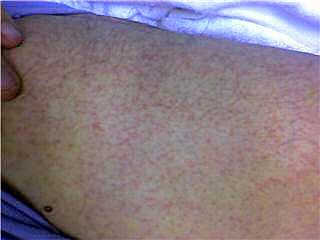- Clinical Technology
- Adult Immunization
- Hepatology
- Pediatric Immunization
- Screening
- Psychiatry
- Allergy
- Women's Health
- Cardiology
- Pediatrics
- Dermatology
- Endocrinology
- Pain Management
- Gastroenterology
- Infectious Disease
- Obesity Medicine
- Rheumatology
- Nephrology
- Neurology
- Pulmonology
Dengue Fever
Recent travel to the Caribbean is the key clue that led to the diagnosis of dengue fever, which caused maculopapular rash, fever, headaches, and body aches.
Figure (click image to enlarge)

You are seeing your last patient of the day when your partner asks you for a second opinion on a rash. The patient is a 43-year-old businessman who complains of fever, rash, headaches, and body aches. He denies any cough, sore throat, or runny nose as well as any vomiting, photophobia, or diarrhea. He has never had a rash like this before. His symptoms all wax and wane, and have been present for 3 days.
His past medical history is notable only for high cholesterol, for which he has taken simvastatin for many years. He has been taking acetaminophen for his fevers (temperatures as high as 103.1°F). He does not smoke or use recreational drugs, but drinks socially and travels frequently for work.
On physical exam, he appears non-toxic. His vital signs are normal, except for an oral temperature of 101.8°F. His eyes and oropharynx are clear, as are his lungs. He has no neck stiffness or photophobia and his neurologic exam is normal. The rest of his exam is unremarkable except for the rash, which is all over his body (Figure).
His CBC count and metabolic panel are normal. His white count is 1.7/µL.
You ask the patient one question, which your partner had not asked, and nail the diagnosis.
What is the differential diagnosis? What is the question? And the diagnosis?
The differential
The differential diagnosis of a maculopapular rash and fever includes drug reaction, viral exanthema or scarlet fever (both mostly in kids), syphilis, histoplasmosis, fungal infection, HIV, tick-borne infections, toxic shock syndrome (usually has a sun-burn-like rash), dengue, Pseudomonas infection, and folliculitis.
The question
The question is, “where have you traveled recently?” The answer in this case: “The Caribbean.”
The diagnosis
Dengue fever.
Dengue fever is caused by a flavivirus transmitted by the Aedes mosquito, which, unlike many other mosquitos (including the Anopheles mosquito that is the vector for malaria), tends to bite during the day and is also more common in urban areas. It is commonly contracted in the Caribbean islands as well as in Latin America and Southeast Asia. The incubation period is typically between 4 and 7 days.
The clinical presentation of dengue involves high spiking fevers associated with severe body aches, which give it the nickname of Break-Bone Fever. There may also be severe headache as well as nausea, vomiting, and diarrhea, which can lead to dehydration.
The rash of dengue fever usually starts after the other symptoms and is typically maculopapular, but can become petechial. Interestingly, if a blood pressure cuff is left inflated for a prolonged period above the mean arterial pressure, a shower of petechiae can occur distal to the cuff: this finding is known as the Rumpel-Leede phenomenon.
Lab test results may be normal, but often the white blood cell and platelet counts are low and liver transaminase levels are elevated. The diagnosis can be made either by an enzyme immunoassay for IgM or with PCR. The former may not become positive until the fourth or fifth day of symptoms, while the latter is generally within 1 to 4 days of the onset of symptoms.
Treatment for dengue is generally supportive. Antiemetics and analgesics may be useful. However, NSAIDs should be avoided, since complications of dengue can include GI bleeding. Sicker patients may require IV fluids and even hospitalization in severe or complicated cases. The main complication is hemorrhagic dengue, which can involve GI bleeding, petechiae, and shock as well as intracranial bleeding, myocarditis, and retinal disease.
Epidemiology:
Also known as Break-bone fever: Transmitted by the urban, daytime-biting Aedes mosquito. Common in Southeast Asia, the Caribbean, and Latin America. A flavivirus, incubation 4-7 days.
Tests:
Labs:
Complications:
Hemorrhagic Dengue: petechiae, low platelets, shock, hepatitis, CNS bleed, myocarditis, retinopathy
Rx:
